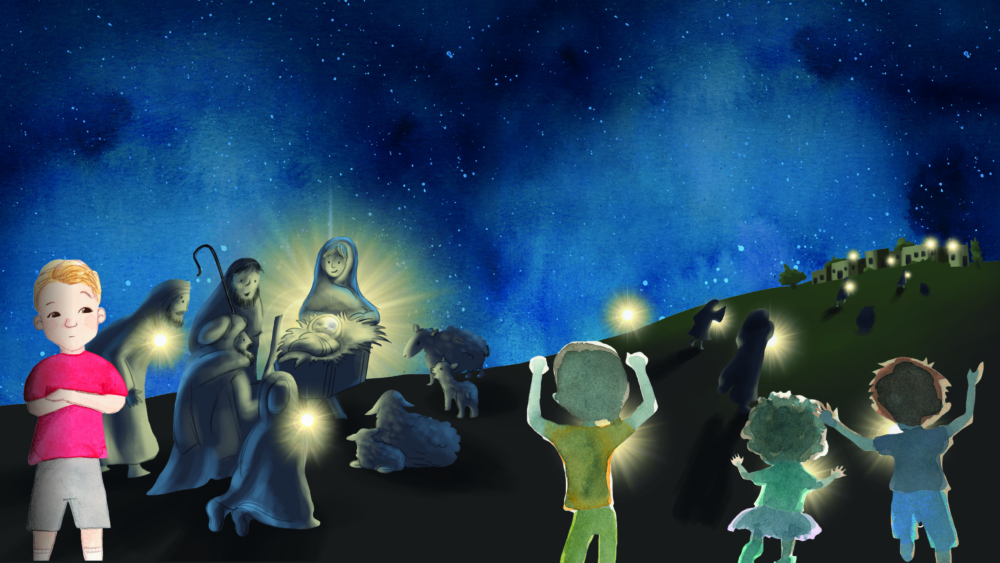Christmas for kids, with a bit of anarchy thrown in
A new picture book about the radical reality of Jesus’ birth
When celebrated author and publisher Susannah McFarlane was writing Who? What? Why? How? Christmas, a children’s picture book for Bible Society Australia, she happened to be also writing a group of fairy tales.
“I was struck by God’s sense of symmetry,” says McFarlane, who is Bible Society’s Head of Publishing.
“For me, what finally cracked through was the reality of it.” – Susannah McFarlane
“On the one hand, I’m writing these fairy tales and on the other one I’m writing effectively a non-fiction that many people believe to be a fiction story or fairy tale.”
Author of the EJ12 Girl Hero and EJ Spy School series, McFarlane has been involved with publishing or writing children’s books which have sold more than three million copies in Australia alone. For this successful writer of children’s fiction, who describes herself as “a reluctant convert” to Christianity after failing to disprove Jesus’ resurrection to a friend, it was important to emphasise the reality of the Christmas story.
“I only became a Christian 3½ years ago, so God’s got an amazing sense of humour,” says McFarlane.
“To give a ‘child’ the job of writing the Christmas story book was perfect, spiritually. I’ve still got a lot to learn and I am probably spiritually the target age of the picture book.
“For me, what finally cracked through was the reality of it. So if you’re telling a story, you have to completely break the thing that this is a parable, this is a metaphor.”
The biggest difference from a traditional Christmas book is this one starts with Creation and The Fall, rather than with the virgin Mary being told of her divine baby.

Susannah McFarlane
McFarlane started there because she realised that a lot of children in our post-Christian society are not aware of the back story of Christmas. She notes how a family member’s child hadn’t even heard of God.
“So it needed to be a different story. To me, there was no point talking about the birth of a saviour if people don’t understand what we need to be saved from,” she says.
“You need to say why we needed to be saved – otherwise, why is everyone getting so excited about the baby?”
Another way she disrupts the usual format is by introducing four child characters – Josh, Tom, Grace and Abby – whose doubts, questions and misunderstandings intersperse the narrative. For McFarlane, that introduces a bit of anarchy that may appeal to older children and provides a way of answering the reasonable objections of non-Christian adults.
“The four kids each have a different faith position, which may or may not be apparent to people reading it, but I needed to anchor them into something.
“Josh thinks the whole thing is pretty lame, Tom is our doubting Thomas, Grace is a Christian and Abby is three, so she thinks everything is great,” McFarlane says, adding she will develop the four kids’ faith journeys further in the book she is writing for Easter.
Something else that struck McFarlane about traditional Christmas story books was how they gloss over the appearance of the Angel Gabriel to Mary.
“Everyone thinks they know it, everyone can tell it in their sleep – we just gloss over that an angel came to Mary’s house; hold on, if an angel came to your house, it would be the biggest thing that ever happened in your life. And we just gloss over it, as a preamble to something else.”
Who? What? Why? How? Christmas presents Gabriel as an awesome warrior – not the anodyne tinsel figure that sits on top of the Christmas tree. “It was trying to unpack all those words that we use all the time in the Christmas story, to unpack the cliché and pull people up a bit and think if it really was a thing,” she says.
“Jesus is the superhero who saved the world – the others are just pale fictional imitations.” – Susannah McFarlane
Another way she has subverted the conventions of children’s Christmas books is by having the wise men come to visit Jesus years after the shepherds.
“It completely upsets most people’s idea of the nativity scene but, again, it’s the reality of it. It really did happen, so facts matter.”
One metaphor Susannah does allow, in a nod to kids’ tastes, is that of Jesus as superhero.
“Kids relate to that because it’s everywhere at the moment. They know superheroes save people from bad stuff and they’re somehow bigger than us, so to play that kind of conceit into it works. Because Jesus is the superhero who saved the world – the others are just pale fictional imitations.”
As in the past two years, Bible Society Australia is offering free Christmas books to individuals and churches who register online.
You will receive an alert email as soon as the offer is available. The church offer is due to open on October 1 and the individual offer opens on November 1.


